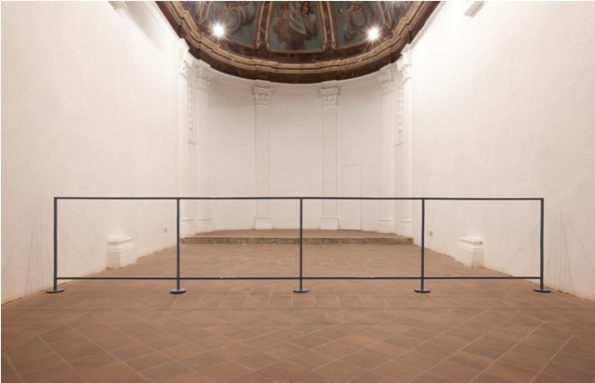Search
To search for an exact match, type the word or phrase you want in quotation marks.
A*DESK has been offering since 2002 contents about criticism and contemporary art. A*DESK has become consolidated thanks to all those who have believed in the project, all those who have followed us, debating, participating and collaborating. Many people have collaborated with A*DESK, and continue to do so. Their efforts, knowledge and belief in the project are what make it grow internationally. At A*DESK we have also generated work for over one hundred professionals in culture, from small collaborations with reviews and classes, to more prolonged and intense collaborations.
At A*DESK we believe in the need for free and universal access to culture and knowledge. We want to carry on being independent, remaining open to more ideas and opinions. If you believe in A*DESK, we need your backing to be able to continue. You can now participate in the project by supporting it. You can choose how much you want to contribute to the project.
You can decide how much you want to bring to the project.

The gesture feigns simplicity, but Mirador (Look out) by Oriol Vilanova articulates a considerably complex situation in a surrounding that, in itself appears almost empty. In the twilight of idols, Vilanova follows the traces of iconoclasm that snoop around our days and proposes something notably intelligent in relation to the construction of the visible. The project skirts around semiotics to go that bit deeper and question what it is that, finding itself ruined as a sign, still signifies: to what extent does iconoclasm influence the construction of the gaze today? Just as what is perceived as absent or empty is inscribed within the structure of the scopic regime?
If witnessing the empty exhibition space was one of the nodes that articulated his celebrated performance Ells no poden morir (They can´t die) (La Virreina Centre de la Imatge and MUSAC, 2011), the opening of a panoramic view in the Capella de Sant Roc de Valls is accompanied, in the case of Mirador, by a meticulous exercise in microscopy that aims to scrutinize the eye of the spectator as a cultural construction. Once it has also become empty, a first dose of strabismus occurs in the complicated coexistence that arises between the old baroque chapel and the more recent exhibition space. From the railing of Mirador, the spectacle that is witnessed is nothing more than that of the exhibition space that unfolds, with difficulty, in the interior of a church, which, given its painted vaults and mouldings, impedes the presumption of the aseptic white cube; at the same time as the chapel is also unable to take advantage of the lack of exhibition to re-establish itself and recuperate its ritual.
Enough has been said about the lines of continuity between the religious space and the museum space. Carol Duncan considers, for example, the museum as a structure that is strictly ritualistic, a ceremonial space that, just like a church, universalises and transmits a truth, in this case a secular one; with visitors, Pierre Bourdieu would add, on whom is imposed a religious silence, the ascetic purism of the spaces and the grandiose solemnity of the decoration. Likewise, the modern art gallery, the so-called “white cube”, has been constructed, according to Brian O’Doherty, by way of a law as rigorous as the one that was employed in medieval churches; to give rise, finally, to an art practice that emerges autonomously and idealised and, according to what Grant H. Kester indicates, precisely as a “displaced theology”.
But in Valls, the astuteness of Vilanova leads him to describe in detail this relation between the church and museum when it is proposed in light of iconoclasm. The Chapel of Sant Roc was secularised during the Civil War, the time when the altarpiece was burnt. Even so, the iconoclastic action culminated in the year 1985, when in order to hold contemporary art exhibitions, its walls, interfering with the logic of the white cube, were covered in white, the endeavour being to make them disappear from the field of vision. So there are two underlying types of space but also two types of iconoclasm, the one that is politically motivated and the one motivated by aesthetics or spirituality. And curiously the modern art tradition straddles both: if the dismantling of the old regime is what led to the formation of the first public museums –with the destruction of religious images and the formation of the Louvre at the forefront of the French Revolution -, in its turn the subsequent formation of the white cube, at the beginning of the 20th century, is nothing more than a turn towards the religious asceticism of the Judeo-Christian tradition that, historically, has also led to different episodes of regulation, prohibition and the destruction of images.
Divesting the exhibition space of artistic images is also an iconoclastic gesture on Vilanova’s part, with which he approximates a repetition of the revolutionary and dismantling process more than he reduplicates the spiritual asceticism of the white cube. It is precisely the lack of exhibition that leads in this case to the emergence of a scenario that opens up into two and evidences the incongruities that underlie the convergence between the religious and the museum space. The iconoclasm of Vilanova disrobes the space, going against the grain of two architectural modes for invoking purity and transcendence, neither of which can reach completeness, revealing them ultimately as the fruit of contingent and mundane acts of mediation.
Likewise it is important to consider that from the railing of the Mirador the space reverberates specifically as historic testimony, in this way also differentiating the object from the average minimalist intervention. While the appearance is close to the modular structures of Sol Le Witt or even the cut that Michael Asher introduced in 1970 to the Gladys K. Montgomery Art Center Gallery, the fact that the rupturing of the white cube is produced by inducing a historic sense of temporality, leads it conceptually in this case to resemble to a greater extent, for example, the documentary juxtapositions that conform the FX Archive by Pedro G. Romero, also around iconoclasm.
But the definitive twist is in relation to the eye of the spectator. In this regard, the project serves as a tromp l’oeil, as when the spectator is invited to situate his viewpoint in the centre of the space, the railing immediately becomes an operating table where it is the spectator’s eye that is observed. So in a way no less centripetal than the well-known diagram by Herbert Bayer for the design of exhibitions, the white cube historically appeared as a space disposed to govern the eye of the spectator. But just as Mirador discovers, the iconoclasm is not merely empty but is also a deliberate and constitutive action of a specific scopic regime.

Mirador in this sense also places the two iconoclasms side by side, facilitating the allegedly totalitarian vision of the modern museum space, alongside the impeded vision that results from the destruction of the images. And when to the spectator it seems, having reached the centre of the space, that there is nothing to be seen from the railing, what in reality he is being invited to do is observe the blind points that constitute the act of looking. To glance beyond the field of the exhibition space, to the “optical unconscious” in the terminology of Rosalind Krauss, to those aspects that, being generally invisible, tame the gaze and even facilitate the construction of the very myth of total vision.
In the sheet about the exhibition, the artist as much as Joana Hurtado, the curator of the project, go round in circles looking at blindness, to the point that they propose it as a possibility for liberation from the hegemony that vision has in our society. On my part I wouldn´t be so optimistic, and I think that the challenge that the project proposes is to remain sighted. Mirador is a place from where to observe how the bonfire of the vanities and the destruction of the images projects a gaze that still grabs us in our construction as spectators.

Oriol Fontdevila thinks that the political and social dimensions of art practices and cultural phenomena are interesting; that the question of cultural innovation ought to be dealt in correlation with that of social progress: that cross-disciplinary working is an opportunity, not just to accumulate knowledge, but to generate surroundings from where to challenge them; and that art criticism and curating can contribute in this respect.
"A desk is a dangerous place from which to watch the world" (John Le Carré)